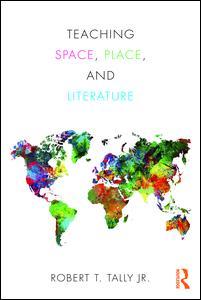Teaching Space, Place, and Literature
Coordonnateur : Tally Jr. Robert

Space, place and mapping have become key concepts in literary and cultural studies. The transformational effects of postcolonialism, globalization, and the rise of ever more advanced information technologies helped to push space and spatiality into the foreground, as traditional spatial or geographic limits are erased or redrawn. Teaching Space, Place and Literature surveys a broad expanse of literary critical, theoretical, historical territories, as it presents both an introduction to teaching spatial literary studies and an essential guide to scholarly research. Divided into sections on key concepts and issues; teaching strategies; urban spaces; place, race and gender and spatiality, periods and genres, this comprehensive book is the ideal way to approach the teaching of space and place in the humanities classroom.
Introduction: The Map and the Study of Literature Part 1. Key Concepts and Issues Introduction 1. Space Odyssey: From Place to Lived Space, Gerard van den Heever 2. The Nomadic Classroom: Encountering Literary Art through Affective Learning, Christian Beck 3. An Interdisciplinary Pedagogy for a Graduate Course in Spatial Studies, Jordan Hill 4. Mapping Multiethnic Texts in the Literary Classroom: GIS and Karen Tei Yamashita’s Tropic of Orange, Anastasia Lin 5. Teaching Literary Cartographies of Race, Space, Place, and Displacement, Jessica Maucione 6. "Out of Doors": Shakespeare and the Forest School Movement, Lynsey McCulloch 7. Teaching Victorian Literature through Cartography, Susan E. Cook 8. Thinking Geocritically: Teaching Canadian Literature in Treaty 6 Territory, Sarah Wylie Krotz Part 2. Representing Space and Place 9. Panoramic Perspectives and City Rambles: Teaching Urban Literary Studies, Lieven Ameel 10. Modeling Interdisciplinarity: Spaces of Modern Paris through Literature and Design, Andrea Goulet and Eugenie L. Birch 11. From Ashes to Phoenix: A Geocritical Approach to Teaching the Literary Landscapes of Eighteenth-Century London, Catharina Loeffler 12. Interrogating the Urban Crisis: Teaching Detroit in Literature, Frank D. Rashid 13. Place as Palimpsest: Literary Works and Cultural-Political Resistance, Andrea Quaid 14. Space, Place, and Gender: Women and Geography in the American Literature Survey, Geneva M. Gano 15. "But wither am I wandering?": Gender, Class, and Writing Space in Mary Wollstonecraft’s Letters Written During a Short Residence in Sweden, Norway, and Denmark, Kathryn Walchester Part 3. Critical Domains 16. Space and Place in Fictional Storyworlds, Mihai Mindra 17. Space, Movement, and Modern Literature, Scott Cohen 18. Literature and the Medieval English "Borderland": Teaching the Culture of Identity and Place, Ruth Oldman 19. Teaching the Importance of Space and Place: Robert Stepto’s "Ritual Grounds", Wendy Rountree 20. Multiple Identities and Imaginative Spatiality in Kipling’s Kim and Rushdie’s Midnight’s Children, Safia Sahli Rejeb 21. Teaching Non-Places in British Children’s Fantasy Literature, Hannah Swamidoss 22. Key Concepts and the Thriller: Space, Place, and Mapping, Ralph Crane, Lisa Fletcher, and Elizabeth Leane
Robert T. Tally Jr. is Professor of English at Texas State University, where he teaches American and world literature.
Date de parution : 11-2017
15.6x23.4 cm
Date de parution : 10-2017
15.6x23.4 cm
Thème de Teaching Space, Place, and Literature :
Mots-clés :
Mitterand’s Grand Projet; Spatial Literary Studies; Critical Spatiality Theory; Sag Harbor; American Literature Survey; Leimert Park; critical; Literary Cartographies; spatiality; Virtual Learning Community; theory; Forest School; forest; Stratigraphic Vision; school; Spatial Turn; Robert T; Tally; Vice Versa; Gerhard van den Heever; Above Ground; Christian Beck; UN; Jordan Hill; III’s Regime; Anastasia Lin; Ritual Grounds; Jessica Maucione; Young Man; Lynsey McCulloch; Midnight’s Children; Susan E; Cook; Geocritical Approach; Sarah Wylie Krotz; Deictic Shift; Lieven Ameel; City Walker; Andrea Goulet; Deictic Center; Eugenie L; Birch; Ethnic American Literature; Catharina Löffler; Borderland Identity; Frank D; Rashid; Le Corbusier; Andrea Quaid; Geneva M; Gano; Kathryn Walchester; Mihai Mindra; Scott Cohen; Ruth Oldman; Wendy Rountree; Safia Sahli; Hannah Swamidoss; Ralph Crane; Lisa Fletcher; Elizabeth Leane


